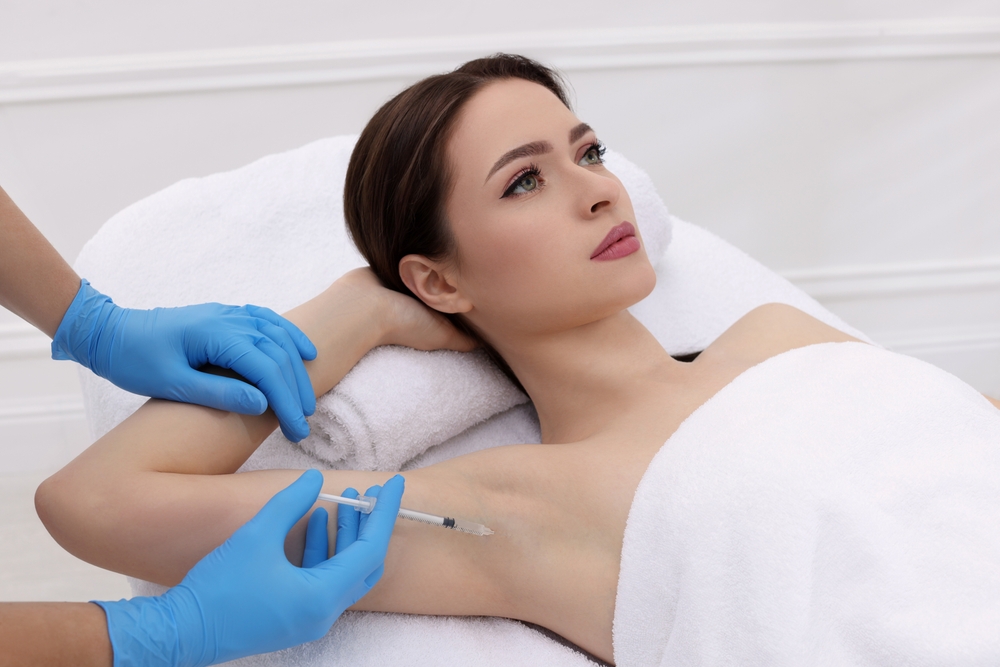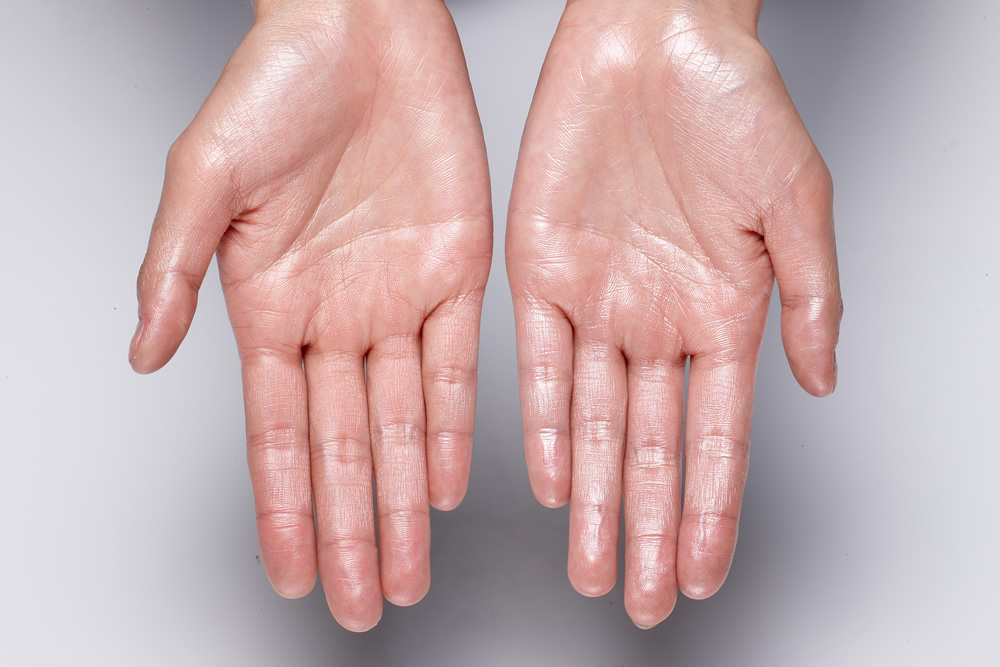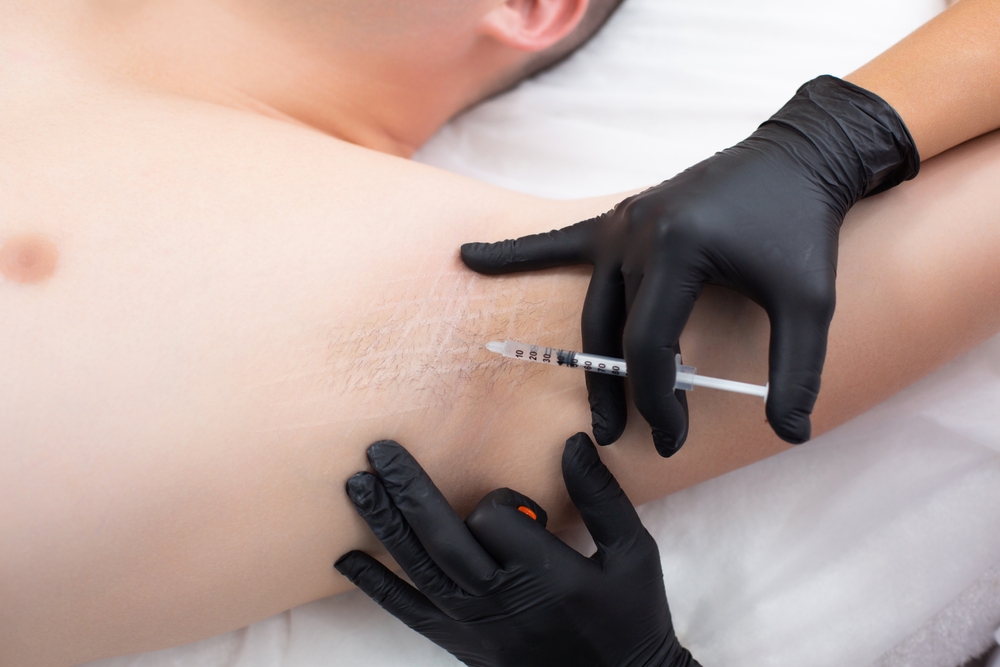Types of Hyperhidrosis & Sweat Conditions
Hyperhidrosis is a medical condition characterized by excessive sweating without an obvious cause, such as heat, exercise, anxiety, or other factors. Over 15 million people in the United States alone suffer from hyperhidrosis, with many reporting that it disrupts their daily lives and significantly impacts their quality of life. The most commonly affected areas are the armpits, palms, and soles because of the high concentration of sweat glands in those regions. Hyperhidrosis can affect how you live, preventing you from enjoying social activities due to the fear of embarrassment when lifting your arms or shaking hands. Fortunately, hyperhidrosis can be diagnosed and treated with various non-invasive options available through Dr. Michele Green in NYC.
Hyperhidrosis is categorized into two main types: primary and secondary. Primary hyperhidrosis is often inherited, causing overactive sweat glands in specific areas like the underarms and hands. Many people develop primary hyperhidrosis during childhood and may experience excessive sweating at least once a week. While this condition requires lifelong management, many effective treatments are available, including topical medications, oral prescriptions, and in-office procedures such as Botox injections. Secondary hyperhidrosis, however, occurs due to an underlying health condition or as a side effect of medication or supplements. Usually, symptoms improve once the medical issue is addressed or the medication is changed. When you see Dr. Green at her boutique dermatology practice in New York City, she will develop a personalized treatment plan based on your type of hyperhidrosis, the affected areas, and your specific concerns to help you control excessive sweating and improve your overall quality of life.
Dr. Michele Green is a highly acclaimed, board-certified dermatologist based in New York City with over 25 years of experience providing some of the world’s most discerning patients with top non-invasive treatments, including for hyperhidrosis management. Dr. Green takes a holistic approach, customizing each patient’s treatment plan to their specific concerns. She is consistently recognized as one of New York City’s leading dermatologists by Castle Connolly, New York Magazine, The New York Times, and Super Doctors for her dedication and expertise. When consulting with Dr. Green about hyperhidrosis, she will review your medical and family history, conduct a physical exam, and may order additional diagnostic tests to determine the best treatment options for your individual needs. Whether your excessive sweating impacts only your underarms or hands, or involves your entire body, Dr. Green will help you develop the most appropriate treatment plan.
What is hyperhidrosis?
Hyperhidrosis is a medical condition marked by excessive sweating not caused by typical factors such as heat or exercise. Sweating, or perspiration, is a normal process that helps cool the body. Usually, when body temperature rises, the autonomic nervous system triggers the release of acetylcholine, signaling the eccrine sweat glands to produce sweat that lowers body temperature. However, people with hyperhidrosis sweat even when their body temperature is normal. This condition can occur anywhere on the body where sweat glands are present, but it most commonly appears on the underarms, palms, and soles of the feet. Hyperhidrosis can be frustrating and negatively impact self-esteem, with many patients reporting that it frequently interferes with daily activities and overall quality of life. Additionally, if left untreated, hyperhidrosis can cause skin irritation, increased body odor, and skin infections. While there is no cure for hyperhidrosis, Dr. Green provides various topical treatments, oral medications, and in-office procedures to help manage the condition and boost confidence and self-esteem.

How many types of hyperhidrosis are there?
There are two types of hyperhidrosis: primary hyperhidrosis and secondary hyperhidrosis.
Primary hyperhidrosis
Primary focal hyperhidrosis, also called type 1 hyperhidrosis, involves excessive sweating caused by overactive sweat glands without other medical conditions or medications. It usually affects specific areas of the body, such as the armpits (axillary hyperhidrosis), hands (palmar hyperhidrosis), and feet (plantar hyperhidrosis). Most individuals develop this condition during childhood and experience symmetrical sweating on both sides of the body. Although excessive sweating occurs during the day, the American Academy of Dermatology states that night sweats are generally not related to primary hyperhidrosis. While there is no cure for primary hyperhidrosis, symptoms can be safely and effectively managed through various treatment options provided by a board-certified dermatologist like Dr. Green.
Secondary hyperhidrosis
Secondary hyperhidrosis, also called type 2 hyperhidrosis, refers to excessive sweating caused by an underlying condition or as a side effect of medication or supplements. This type usually involves widespread excessive sweating that affects the entire body rather than just a specific area. Secondary hyperhidrosis may also present as night sweats during sleep. Conditions that can lead to secondary hyperhidrosis include infectious diseases like malaria, tuberculosis, and HIV; neurological issues such as anxiety, stress, and panic attacks; as well as menopause, diabetes, obesity, low blood sugar, Parkinson’s disease, hyperthyroidism, and lymphoma. Sometimes, secondary hyperhidrosis can be reversed by stopping the medication or supplement or by treating the underlying condition. It can also be managed with oral or topical medications, prescription antiperspirants, Botox injections, or a combination of these treatments. If you experience generalized excessive sweating, it’s best to consult a healthcare provider to identify the underlying cause of your hyperhidrosis.
What is the most common form of primary hyperhidrosis?
The most common type of primary hyperhidrosis is axillary hyperhidrosis, or excessive sweating in the underarms. Patients experience this kind of hyperhidrosis symmetrically, and it can be distressing because it leaves visible stains on clothing. Although there is no cure for axillary hyperhidrosis, symptoms can be safely and effectively managed with various treatment options offered by a board-certified dermatologist like Dr. Green. Popular treatments at Dr. Michele Green’s boutique NYC dermatology office include Botox injections, which can provide long-term sweat relief with no downtime or side effects.
How do I know if I have primary or secondary hyperhidrosis?
It is often easy to distinguish between primary and secondary hyperhidrosis. Those with primary hyperhidrosis typically notice excessive sweating during childhood, usually in specific areas like the underarms, palms, or soles of the feet. Secondary hyperhidrosis involves generalized excessive sweating that results from a medical condition, medication, or supplement. Many patients with secondary hyperhidrosis experience widespread excessive sweating often within days or weeks after starting a new medication. If excessive sweating occurs for an unknown reason, suddenly disrupts your daily routine, negatively affects your quality of life, or leads to other symptoms, it’s important to consult an experienced healthcare provider, such as board-certified dermatologist Dr. Michele Green in NYC, to understand your hyperhidrosis type and explore treatment options.

What is the root cause of hyperhidrosis?
Unlike typical sweat, hyperhidrosis is not triggered by emotional stimuli (such as anxiety and fear), thermal stimuli (heat and exercise), or certain foods (like spicy foods or alcohol). Hyperhidrosis lacks specific triggers, and patients often notice they sweat without any apparent stimuli. It is believed that primary hyperhidrosis develops due to genetic factors or abnormal nerve signals from the nervous system. Secondary hyperhidrosis results from an underlying medical condition or as a side effect of certain medications or supplements. Generalized hyperhidrosis may indicate a health issue such as diabetes, Parkinson’s disease, thyroid problems, or certain cancers, as well as hormonal changes like menopause or hyperthyroidism, or medication use, especially certain antipsychotics and opioids. The best way to identify the cause of your hyperhidrosis is to see a board-certified doctor, like Dr. Michele Green, who can assess your symptoms and determine the underlying reason.
How to treat hyperhidrosis
Although there is no cure for hyperhidrosis, a board-certified dermatologist like Dr. Michele Green in NYC can treat it using various in-office procedures, oral medications, and topical prescriptions. When you meet with Dr. Green in her private NYC dermatology office, she will review your medical history and concerns to create a personalized treatment plan to help you achieve dry, sweat-free skin.
Botox injections for axillary hyperhidrosis treatment
Botox, the brand name for the neurotoxin botulinum toxin, is FDA-approved for treating excessive underarm sweating, also known as axillary hyperhidrosis. Botox works to inhibit the errant nerve signals that lead to overactive sweat glands, thereby reducing sweat secretion. The procedure is quick and easy, with no downtime, allowing patients to resume their daily activities immediately. Common side effects of Botox injections include mild swelling, bruising, and tenderness at or near the injection sites, which typically resolve within two weeks post-treatment. The effects of Botox injections take up to two weeks to manifest and can last from 4 to 6 months, depending on the treated area. Patients are advised to attend regular treatment sessions to maintain optimal sweat-free results. Botox injections are Dr. Green’s preferred option for hyperhidrosis due to their safety and effectiveness in alleviating excessive sweating.
Brella by Candesant Biomedical
Brella is a non-invasive treatment for axillary hyperhidrosis. It uses targeted alkali thermolysis (TAT) technology to heat and deactivate sweat glands, effectively reducing excessive sweating in the underarms. Each Brella patch is single-use and disposable, with results lasting 3-4 months after each treatment.
Iontophoresis for palmar and plantar hyperhidrosis
Iontophoresis is an FDA-approved method for treating palmar and plantar hyperhidrosis. The affected area is submerged in water and exposed to a low electric current, which blocks sweat glands and reduces excessive sweating. To achieve optimal results, treatment should be performed multiple times a week, followed by maintenance sessions.
MiraDry for axillary hyperhidrosis
MiraDry is an FDA-approved procedure for axillary hyperhidrosis. It uses precise microwave energy to target and destroy sweat glands in the underarms. Once destroyed, the sweat glands do not regenerate, effectively stopping excessive sweating.
Surgery for hyperhidrosis
The most common surgical treatment is endoscopic thoracic sympathectomy (ETS). ETS involves a surgeon clamping or burning the sympathetic nerve endings to block the signals that cause sweating. Another option includes surgically removing sweat glands using lasers, liposuction, or curettage techniques. Surgical treatment is usually reserved only for very severe cases of hyperhidrosis. After surgery, some patients may experience Horner’s syndrome or compensatory sweating in other parts of the body. Many patients prefer Botox injections for hyperhidrosis treatment because they carry little risk and require no downtime.

Oral Medications for Excessive Sweating
- Anticholinergics are oral medications that chemically block the nerve endings of eccrine sweat glands to inhibit nerve signaling and prevent excessive sweating. The most commonly prescribed anticholinergics include glycopyrrolate, oxybutynin, benztropine, and propantheline. Anticholinergics are typically prescribed for patients with secondary hyperhidrosis who experience generalized excessive sweating, as these medications work systemically. While they are effective in treating hyperhidrosis, they can cause side effects such as dry mouth and blurred vision, among others.
- Benzodiazepines are a class of medications that are primarily antidepressants but have also been found effective in treating hyperhidrosis. They work by reducing anxiety, which often leads to excessive sweating.
- Beta-blockers, such as propranolol, have also been successful in treating excessive sweating. They work similarly to antidepressants by acting on the central nervous system to help manage anxiety symptoms.
Topical Medications for Excessive Sweating
- Drysol is a common topical antiperspirant containing 20 percent aluminum chloride, which is available by prescription. When aluminum chloride interacts with sweat, it creates a precipitate that forms a plug in the sweat gland ducts, preventing sweat from being released. However, it is not recommended to use aluminum chloride as a long-term solution, as it may cause skin and eye irritation in some individuals.
- Glycopyrronium tosylate is a topical anticholinergic treatment that the FDA has approved under the brand name Qbrexza. These wipes are available in pre-moistened, individually wrapped, single-use packages, making them easy to use. Qbrexza is convenient because its packaging allows teens and adults to carry and use it while exercising to reduce excessive sweating.
- Sofdra is an FDA-approved topical gel used to treat axillary hyperhidrosis. This gel contains sofpironium bromide, which works by signaling sweat glands to reduce sweat production. Sofdra is applied nightly to the underarms to help manage hyperhidrosis symptoms.
Over-the-counter medication for managing hyperhidrosis
Many new products are being developed and studied to treat hyperhidrosis, including antiperspirant deodorants, hand creams, foot creams, and body antiperspirants. Key active ingredients for managing excessive sweating include aluminum chloride, aluminum chlorohydrate, and aluminum zirconium. These compounds work by reacting with sweat to form a gel that stays on the skin, blocking the sweat gland ducts and creating a temporary plug. Antiperspirant deodorants are available in various forms, such as sticks, gels, sprays, and wipes.
How do I permanently stop hyperhidrosis?
Unfortunately, there is no permanent cure for primary hyperhidrosis, as it is not caused by an underlying medical condition or medication. Patients with secondary hyperhidrosis may find relief once the underlying condition is treated or their medication is adjusted. In either case, patients can safely and effectively manage symptoms with various treatment options under the care of board-certified dermatologist Dr. Michele Green in New York City. One of Dr. Green’s preferred treatments for hyperhidrosis is Botox injections, which can provide long-lasting relief for localized sweating. Other management options include topical antiperspirants, Qbrexza anticholinergic wipes, and oral medications. When you consult with Dr. Green, she will review your medical history and skin condition to develop the most effective treatment plan for long-term relief.
Frequently Asked Questions (FAQs) About Excessive Sweating
What are the three types of sweating?
People sweat in response to different stimuli. The three types of sweating are thermal, emotional, and gustatory. Thermal sweating happens when the body temperature rises, such as during hot weather or exercise. People with working sweat glands will experience thermal sweating. Emotional sweating occurs when someone feels stress, anxiety, fear, or pain. Many notice their palms sweating when they are anxious or nervous. Gustatory sweating happens while eating or even thinking about food. Also called Frey’s syndrome, gustatory sweating can result from damage to the auriculotemporal nerve, which may happen due to surgery or trauma.
Do I have hyperhidrosis, or am I just sweating?
Hyperhidrosis is different from typical thermal, emotional, or gustatory sweating. Unlike regular sweating, hyperhidrosis is not triggered by any stimuli and results from overactive or abnormal nerve signals to eccrine sweat glands. Primary hyperhidrosis involves localized excessive sweating, usually in the armpits, hands, and feet, likely due to genetic factors. Secondary hyperhidrosis causes widespread excessive sweating linked to an underlying medical condition, new medication, or supplement. If you notice excessive sweating not caused by heat, exercise, anxiety, fear, spicy foods, or alcohol, you might have hyperhidrosis. In the past, a starch-iodine test was used to identify areas of excessive sweating. Today, providers mainly diagnose hyperhidrosis through medical history and visual examination. If you’re unsure whether you have hyperhidrosis or normal sweating, it’s best to consult with a board-certified dermatologist, like Dr. Green in NYC.
How to fix primary hyperhidrosis
Although there is currently no cure for primary hyperhidrosis, various treatments can help manage symptoms and minimize excessive sweating. A popular option in Dr. Michele Green’s private NYC office is Botox injections, which work by blocking nerve signals in the treated area. When used in the underarms, Botox reduces signals to the sweat glands, leading to less sweating. These injections are very safe and effective for axillary hyperhidrosis, especially when administered by a skilled, board-certified dermatologist like Dr. Green. Botox can also be injected into the hands to treat palmar hyperhidrosis. Patients usually experience symptom relief for about four months after each treatment. Other options for primary hyperhidrosis include topical antiperspirants, Qbrexza anticholinergic wipes, and oral medications. During your consultation, Dr. Green will review your medical history and concerns to create a personalized plan to help you stay sweat-free.
How to fix secondary hyperhidrosis
Secondary hyperhidrosis results from an underlying medical condition, a medication side effect, or a supplement. Many patients develop secondary hyperhidrosis due to illnesses such as malaria, HIV, tuberculosis, anxiety, menopause, obesity, diabetes, hyperthyroidism, Parkinson’s disease, and lymphoma. Common medications that can trigger secondary hyperhidrosis include antidepressants, diabetes drugs, certain hormone therapies, opioids, and specific antibiotics. If you experience widespread excessive sweating or sweating that begins after starting a medication, it is essential to consult your healthcare provider for proper treatment. Often, addressing the underlying condition, switching medications, or adjusting supplements can significantly reduce or eliminate hyperhidrosis symptoms. If symptoms persist, patients may consider Botox injections, oral medications, or topical treatments to control excessive sweating.
Which neurological disorders cause excessive sweating?
Neurological conditions like Parkinson’s disease or anxiety can lead to excessive sweating. The autonomic nervous system manages sweat response, and neurological issues can interfere with normal nerve function, resulting in problems with temperature regulation. This disruption can send incorrect nerve signals to the eccrine glands, causing them to become overactive and produce too much sweat. To determine if an underlying condition is causing your excessive sweating, patients should always see a healthcare provider, such as board-certified dermatologist Dr. Michele Green. To diagnose hyperhidrosis, your healthcare provider may perform a physical exam, review your medical and family history, and possibly order diagnostic tests to find the cause. Among the treatments available at her private dermatology clinic, Dr. Green offers the best Botox injections in NYC, including for hyperhidrosis. In addition to Botox, a dermatologist like Dr. Green might recommend prescription antiperspirants, supplements, or medications to help manage hyperhidrosis symptoms.
Who is most likely to get hyperhidrosis?
While anyone can develop hyperhidrosis, certain factors may increase the risk. People with a family history of primary hyperhidrosis are more likely to have the condition, as research shows a genetic connection. Patients with primary hyperhidrosis often start experiencing excessive sweating in childhood, usually in specific areas like the underarms, palms, or soles of the feet. Some individuals might develop hyperhidrosis due to health issues, hormonal imbalances, or medications; however, it is impossible to predict if someone will experience excessive sweating before such health problems or medication use.
Is hyperhidrosis a disability?
Hyperhidrosis can be considered a disability because it significantly affects a person’s daily routines and hinders their ability to succeed in work or social settings. It is often seen as a social, emotional, and occupational disability. Excessive sweating can lead to emotional distress, and the social stigma associated with sweating can increase anxiety and stress for those with hyperhidrosis. It can also impact both hands, potentially impairing the ability to perform tasks that require fine motor skills, such as typing, grasping, or carrying objects.
What is the breakthrough in hyperhidrosis treatment?
Currently, many clinical studies and trials are exploring breakthrough treatments for hyperhidrosis. Promising options include a nerve-blocking medication that may reduce excessive sweating without causing side effects like dry mouth, and the new Sofdra gel, which decreases nerve signaling to sweat glands to help control hyperhidrosis symptoms. Numerous trials are ongoing to find effective treatments for excessive sweating.
What kind of doctor treats hyperhidrosis?
Hyperhidrosis is a medical condition that can be diagnosed and treated by a qualified healthcare professional, such as board-certified dermatologist Dr. Michele Green. Dr. Green often recommends Botox injections for axillary hyperhidrosis and may suggest prescription antiperspirant deodorants, supplements, or medications to manage hyperhidrosis symptoms. During your consultation, she will review your medical history to develop the best treatment plan to keep you dry and sweat-free. Other doctors, such as primary care physicians, internists, surgeons, and neurologists, can also help manage hyperhidrosis, especially in cases of secondary hyperhidrosis caused by a medical condition or medication.
What does stress sweat smell like?
Stress sweat is a physiological response triggered by the release of adrenaline and cortisol, which causes the body to produce sweat in preparation for action. It is primarily generated by apocrine glands, a type of sweat gland found in areas with more hair follicles, such as the genitals and armpits. Sweat from these glands is rich in proteins and lipids that, when combined with bacteria on the skin, can lead to body odor. The specific smell may vary based on a person’s diet, hygiene, and genetics, but it is often described as metallic or sour. Odor from stress sweat or other types of sweat can be minimized with deodorants, which aim to kill odor-causing bacteria or mask the smell with fragrance.
Does insurance cover hyperhidrosis treatments?
Typically, insurance covers topical or oral medications for hyperhidrosis. Botox injections for axillary hyperhidrosis (excessive underarm sweating) are usually reimbursed only after other prescribed antiperspirants, topical treatments, and oral medications have been tried. It’s important to contact your specific health insurance provider directly to confirm if your plan covers hyperhidrosis treatments.
How do you get started with hyperhidrosis treatments today?
Hyperhidrosis is a medical condition characterized by uncontrollable, excessive sweating that occurs regardless of exercise, stress, or heat. There are two main types of hyperhidrosis. Primary hyperhidrosis has no known cause and is often linked to genetics, resulting in localized excessive sweating in areas like the armpits, hands, and feet. Secondary hyperhidrosis develops due to an underlying medical condition, medication, or supplement. In some cases, secondary hyperhidrosis may improve once the underlying issue is treated or the medication is changed. Regardless of the cause, symptoms can be managed with various safe and effective treatments offered by a board-certified dermatologist such as Dr. Michele Green in New York City. Common treatments for hyperhidrosis include oral medications, prescription antiperspirants, and Botox injections. If excessive sweating interferes with daily life, causes frequent skin infections, affects confidence, or results in discomfort, Dr. Green in NYC is ready to help.
Dr. Michele Green is an internationally renowned, board-certified cosmetic dermatologist with over 25 years of experience providing her patients around the world with the best non-invasive treatment options, including Botox injections for hyperhidrosis. Offering the latest treatments and utilizing innovative techniques, Dr. Green is consistently recognized as one of the top physicians in New York City by Castle Connolly, New York Magazine, Super Doctors, and The New York Times. When you consult with Dr. Green at her private dermatology office in the Upper East Side neighborhood of Manhattan, she will work with you to develop a personalized treatment plan tailored to your unique skin concerns and goals. To schedule a consultation with Dr. Green and learn more about managing hyperhidrosis and treating excessive sweating with Botox injections, call the NYC office at 212-535-3088 or contact us online today.
 212-535-3088
212-535-3088 